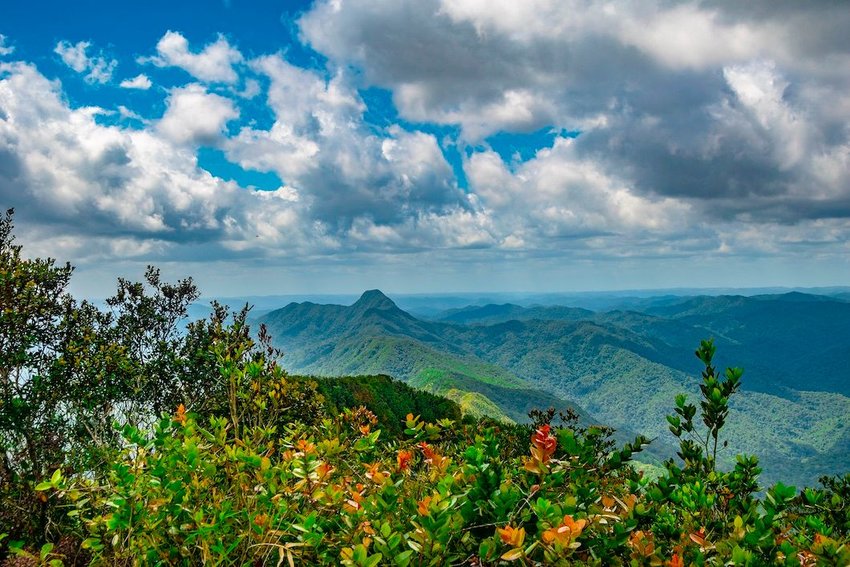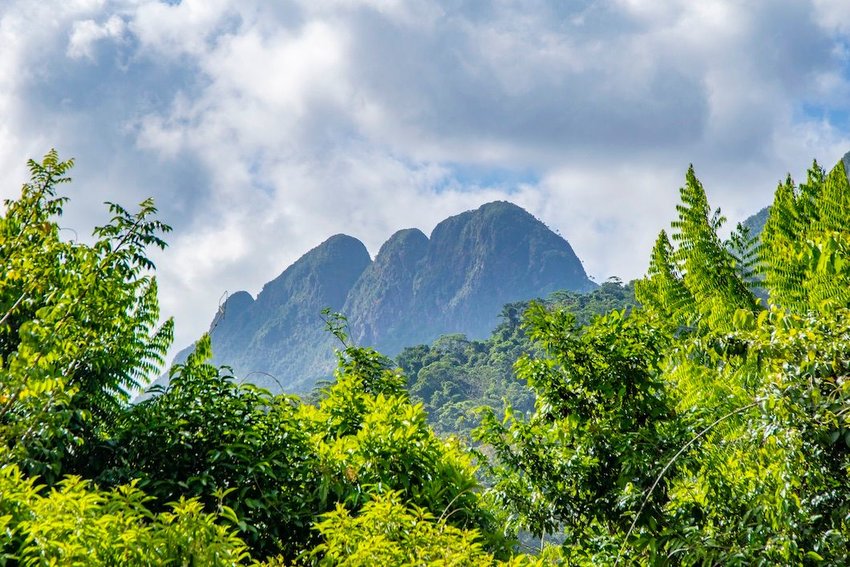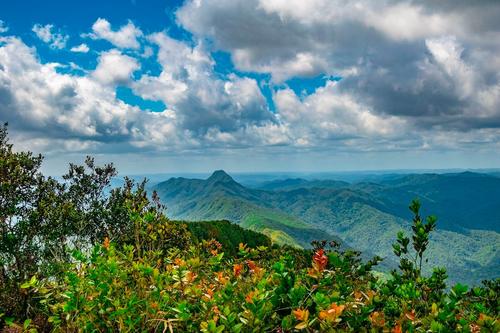Belize is home to one of the largest known concentrations of jaguars on the planet. On a solo-guided trip, I traversed through this Central American jungle and up Victoria Peak to see what I could discover. Here’s how you can, too.
“Come towards me—now,” says Leon Seguro, my hiking partner and local guide, as we stand beneath our remote wood shelter ominously-named, “Dead Man Camp.” The two of us are on a three-day, 30-mile trek through the mountainous jungle of southeast Belize to reach 3,675-foot Victoria Peak, the country’s most iconic and second-highest summit. Today was the first leg of our journey from the trailhead to our two-night hammock outpost. Our team is the only one camping tonight in Cockscomb Basin Wildlife Sanctuary: the oldest, most renowned refuge for jaguars on the globe.
At Seguro’s command, I jump forward. He quickly steps past me and swings his two-foot-long machete. Swhack! “Got it,” he says. A plump, ebony 12-inch-long scorpion tumbles off the ceiling beam. Scorpions inhabit the Southwestern United States, too, where I grew up and played outside, so I’m not frightened as much as I am eager to finally relax, an understated novelty in this life-bursting ecosystem.
We’ve been navigating root-filled, rollercoaster terrain since our 6:20 a.m. sunrise start, more than seven hours ago. I’m foreign to these conditions—100 percent humidity, hovering at 90 degrees Fahrenheit—so I have a stout dehydration headache. Now that we’re here, I really want to sit at our shelter’s picnic table, next to the cocoon hammocks we just hung, to write in my journal. But a few camp duties come first. We have the inaugural permit of the Victoria Peak trek season—February through May, when the weather is driest—so it’s our honor to notify resident critters that visitors are back. Five minutes later, I warn Seguro, “Come this way!” as another scorpion appears behind him. I’m beginning to understand why Seguro loaned me his extra machete for our trek—it’s not because of large, predatory cats.
The World’s First Jaguar Preserve

I first learned about Cockscomb Basin Wildlife Sanctuary when I took a five-day work trip to Belize in 2016. I was visiting Hopkins, a quaint, artistic seaside town on the southeast coast, settled by the Garifuna with a population of 1,500. As much as I love ocean swims and standup paddleboard sessions, I’m an avid hiker. I grew up in Colorado’s San Juan Mountains surrounded by steep slopes and my earliest memories are of learning how to go up. I yearned to explore the region’s trails, especially those with Mayan ruins, cascades, or an apex.
Research showed two hiking areas near Hopkins: Mayflower Bocawina National Park, a 30-minute drive northwest of the coastal community, with a network of singletrack through tropical forest with various ruins and waterfalls. Or, Cockscomb Basin Wildlife Sanctuary, which was southwest and featured arduous climbs, extraordinary wildlife and exotic fauna. The longest trek there was a multiday venture to Victoria Peak, a designated Natural Monument, in the heart of the world’s debut jaguar preserve. Everything in my being was excited by that combo. There are no other comparable long-distance routes in the Belizean backwoods, because tremendous resources are needed to create and maintain one. But the journey would require at least three days to complete, which I didn’t have, so I chose a guided day hike to Mayflower Bocawina’s Antelope Falls, instead. I ended my trip with a satisfying dose of adventure, but I couldn’t stop thinking about those elusive jaguars and the rare opportunity to see one in person.
A Home for Jaguars
In 1984, an ecological study conducted in Cockscomb Basin found the highest density of jaguars ever recorded. Two years later, the wildlife reserve was declared, which has since expanded. Cockscomb Basin Wildlife Sanctuary now protects 128,000 acres and is contiguous with Bladen Nature Reserve for an amassed wilderness area that totals more than 227,000 acres.
It’s difficult for researchers to determine exactly how many jaguars exist today in the reserve. More than 105 jaguars have been documented in Cockscomb Basin Wildlife Sanctuary, said Dominique Lizama, Conservation Programme Director of Belize Audubon Society, however, closer to an estimated 200 jaguars may thrive there, in addition to Puma, Margay, Ocelot, and Jaguarundi. However, sightings are uncommon. In Seguro’s seven-year career as a Victoria Peak guide, he has only seen three jaguars. Each time the jaguar darted away quickly, which makes sense as they are solitary creatures and humans are not their prey, he explained. Only one jaguar attack in Belize has been reported in history, which was an escaped zoo animal rather than one from the wild.
Jaguars catalyzed my intrigue to this place, but I soon realized it would be highly unlikely to see one at all. Regardless, I knew I’d experience an incredible hike in an unparalleled place while pushing my comfort zone and expanding my understanding of life. . Three years later, when I reached out to Seguro, his books were open. He secured our trek permit for March 2019. Now, all I had to do was show up.
A Sunrise Start
From our overnight cabin, Seguro and I walk west on Victoria Peak Trail at daybreak. This 7.5-mile valley floor segment rolls through tropical moist broadleaf forest, full of mahogany and cedar trees, much of which is secondary growth due to logging from the 1930s to 1984. Well-groomed and wide, this section accommodates ATVs, which are used by the Belize Audubon Society researchers and staff to access and maintain the grounds. Mellow mountain streams intersect the trail beneath bridges, which flow from the sanctuary’s East Basin. Beyond the nourishment of jaguars, this reserve has also protected upper watersheds that reach lower-lying populations, prevented further forest decimation, and supported rich biodiversity from scarlet macaws and bat falcons to tayras and crested guans.
Within the first couple of miles, I spot a large, fresh animal footprint in the soft mud. Seguro confirms my excitement — a jaguar recently walked up the trail. My heart spikes at the thought of being so close to seeing one. Five miles later, the route transitions. We step onto a narrow singletrack and enter a dense cosmos of old-growth jungle and begin to climb mountainous terrain. We carefully navigate the obscure path, which is overlain with fallen foliage and roots. A never-ending army of leaf cutter ants zigzags throughout the trail. For 3.5 miles, we ascend steep slopes followed by declines into drainages teeming with rushing cascades and pools of fresh water where I refill my water bottle. I feel like I’m on another planet, surrounded by such lush vegetation, hanging vines, and wavy-grain, red-veined Nargusta trees, which stretch up to 5 feet wide and tower 140 feet high. Several blue morpho butterflies flutter their wings, resting on fallen wood, and a land hermit crab wanders up a dry streambed. Synchronized crickets and calls of common pauraque create constant song.
Near Dead Man Camp, we stop at a clearing on the ridgeline to catch our first glance of Victoria Peak, the highest point in a linear formation of limestone-granite notches that resemble a rooster’s comb, hence the name, Cockscomb Range. By the time we reach camp, we’ve covered a total elevation change of 5,627 feet. After shaking the scorpions from their nests, we settle into our hammocks beneath the clear night sky of stars and twinkling green fireflies.
Summit Day

The next morning, we start hiking at daybreak and need to move consistently to reach the summit and return before dark. The morning light creates a calm ethereal glow against the shrubs, moss, and leaves. I’m on cloud nine, so fascinated by the sublime fauna that I nearly walk into a gigantic spider web. “Watch the spider right next to you,” Seguro, who is above me on the slope, advises. “I avoided that one behind me—I’m good!” I respond. “No—there’s a second one. Look up,” he says. Sure enough, a huge web glimmers across the trail, six inches above my head. I look to my right, and there’s a giant spider, dead-center net. I remove my pack, so I can slide smoothly by without knocking the delicate lattice, then exhale. Huummmmmmmm a loud sound suddenly approaches the other side of my head. I freeze, as tiny hairs stand on the back of my neck. I slowly pivot my head.
“A hummingbird!” I laugh. The Green-breasted Mango floats in front of me with an unbelievable coat of lime-green, turquoise, and gold with a blue-violet tail. We stare at one another, and I smile. Hummingbirds have long been seen as healers, deliverers of joy, and a symbol of adaptability across indigenous cultures. For me, they’re a reminder of home, where we’d hang a feeder on the deck for them each summer. Being approached by one is a good omen for our day ahead.
As we continue, I need to be constantly aware of each step to avoid crossing certain animals like Fer-de-Lance snakes and white-lipped peccaries; but I also realize that this environment is brimming with life, and it’s impossible to not be enriched by being a witness. We continue and reach the base of Victoria Peak, where we drop our packs to begin our scramble up the rock and soft earth. We are less than one mile from the summit, but the climb will take more than an hour, one-way. One steep, short face requires a rope, which Seguro leads, to gain the ridge decorated with fiery high-elevation orchids. From there, the trail reenters an extremely wet tropical forest blanketed with squishy moss, glistening ferns, lush trees, and a relieving moist, cool air. When I reach the crest, I’m so stoked to finally experience this 360-degree panorama. Oscillating ridgelines and endless green growth occupy the horizon in every direction. I feel overwhelming amazement from the interactions, sounds, and sights of this vibrant forest, even without seeing a jaguar.
I feel elated to summit but keep my wits as we descend: We still need to get all the way back to camp. The next day, as we return, we cross paths with the ensuing hiking group. That morning, on their way to the trailhead, they saw a jaguar. I feel a tinge of jealousy at their luck. But I quickly remind myself of all that’s gone well and that which I have to be grateful. I just completed one of the wildest, hardest, most unique expeditions of my entire life. I have so much appreciation for my body’s ability and my mind’s strength. I’m filled with an even deeper awe for Mother Nature and the universe. Even without meeting a giant feline, I’d choose this adventure all over again.
Season: February through May.
Victoria Peak Trail: out-and-back; approximately 28 miles; 10,420 feet of ascent/descent
Pack tips: electrolyte tabs; water filter; bug spray (for the botlass flies); lightweight, protective apparel (to ward off the ticks); Active Skin Repair (for bug bites or cuts)
Travel: Drive 85 miles south from Philip SW Goldson International Airport, in Belize City, is 85 miles north of the Cockscomb Basin Wildlife Sanctuary turnoff. Or, Dangriga Airport is 22 miles. Then, continue west on a 6-mile dirt road to Victoria Peak trailhead.
Guide: Required; book in advance. $100 per person/three-day trek. Leon Seguro, Licensed/Authorized Tour Guide; [email protected]; +501-615-9124. One group—up to 8 visitors/2 guides—allowed per day on summit. Contact Belize Audubon Society for a list of Licensed/Authorized Tour Guides; [email protected].
Fees: Non-national Cockscomb Basin Wildlife Sanctuary Entrance Fee ($4.96 per person). Hammock ($9.93/per person per night). Victoria Peak Trail camping fee ($9.93/per person per night; two night minimum). Pay upon arrival.
Lodging/Laundry: Trailhead cabins ($20-$81.75 per person/per night), or camping ($10 per person per night); reserve at [email protected]. Showers available. In Hopkins, The Lodge at Jaguar Reef Ocean Cottages ($175/night) or The Almond Beach Resort at Jaguar Reef Deluxe Suites ($249/night) are highly recommended; 17-mile drive from Victoria Peak trailhead. Laundry service (which you’ll need) is $10/load.
